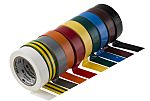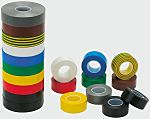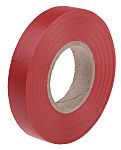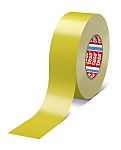|
|
Electrical tape is a safety tape for wires, used to cover and insulate a broad range of cables, wires and other materials that conduct electricity. It’s often referred to as insulating (or thermal insulation) tape, and its uses in workplace and home settings are widespread.
Insulation tapes come in an array of widths and thicknesses for various different applications, as well as in a selection of colours and materials for optimal insulating properties and accurate colour-coding of various wires for safety purposes.
In this guide, we’ll look more closely at some of the specific uses for insulation tape, its key safety features, and a number of the most common kinds of electrical tape available for sale in the UK and beyond.
What is electrical tape made of?
The key properties of a reliable and trustworthy electrical insulating tape are that it must:
-
-
act as an effective insulator against electricity, protecting circuitry and users by not conducting current easily
-
be heat-resistant and fireproof to a reasonable degree for the application it’s being used in
-
be flexible, user-friendly and easy to apply to a range of wires, circuits and connections (often in relatively tight spaces)
-
By far the most common material for electrical tape these days is vinyl, but we’ll investigate more materials and their uses in a later section. For now, we’ll take a closer look at some of the general properties of insulating tape listed above, and how best to use it to make the most of those key attributes.
Does electrical tape conduct electricity?
When used properly, electrical tape should act as an insulator - that is to say, it should protect against transfer of any electrical current passing through the wires to people or components potentially coming into contact with them. As such, properly rated and applied insulating tape should NOT conduct electricity.
How to use electrical insulation tape
Electrical tape is most commonly used in DIY applications for making repairs and joins to smaller wires. As we’ll outline in more detail below, it should not be used for major repairs to very badly damaged wires, or on its own for creating permanent connections in junction boxes, light switches, or wiring outlets.
In these sorts of high-demand, potentially high-temperature environments, insulating tape should only be used in conjunction with purpose-made wire nuts and other connector tools for a safer and more secure fix. Furthermore, electrical tape shouldn’t be used as a standalone repair for damaged or unspliced wires in close proximity to soft furnishings or other flammable materialsCan electrical tape catch fire?
Although most reputable brands of electrical tape will have decent thermal properties (generally to cope with temperatures up to around 80 degrees Celsius), many varieties of insulation tape are indeed flammable if they’re allowed to get hot enough. The likelihood of combustion is usually reasonably low if it’s used sensibly and in the environment for which it was designed, but this will depend entirely on the application in question and the type of tape being used.
Several varieties of electrical insulating tape have much more advanced heat-resistant properties than others. We’ll highlight some of the more specialised types in subsequent sections.
What can I use instead of electrical tape?
There are various alternatives to electrical tape available, with the most popular options including wire connectors (or ‘wire nuts’) and heat-shrink tubing. Wire nuts are typically insulated plastic caps with internal threading that are designed to be twisted on to the ends of stripped wires.
Heat shrinks are very commonly found on wires in smaller electrical components and circuits, but they’re not usually used in household or industrial applications where the wire gauge tends to be much larger.
Other types of adhesive tapes are not generally recommended as a substitute for electrical tape when in direct contact with wiring or circuitry, as they’re designed for other applications and tend to lack sufficient thermal or insulating properties for electrical use, which can mean they quickly become unsafe if deployed incorrectly.
Can you use electrical tape to insulate wire?
One of the main purposes and most common uses of electrical tape worldwide is to insulate and protect wires and other connections. However, it’s worth noting that in many applications, simply twisting wires together and sealing with electrical tape alone is deemed an unsuitable splicing method for meeting stringent safety standards.
Wire nuts are often required in addition to insulating tape for achieving a fully code-compliant setup, so always check any regulations that might apply to the job in question.
Furthermore, always be aware that despite the impressive dielectric performance of many purpose-manufactured electrical tapes, very few materials are always 100% non-conductive under the right combination of circumstances. Given enough voltage and current, a short enough path to ground and in the right/wrong environmental conditions, even the most specialised electrical tape types could potentially conduct enough current to cause serious harm.
Be vigilant of the potential limitations of insulating tapes when used incorrectly or unsafely, and always shut down all circuits to the fullest extent possible before commencing any kind of repair or maintenance work on them.
Electrical Tape vs Duct Tape
It’s very important, when dealing with electrical circuitry, to acknowledge and understand the key differences between an electrical tape and duct tape:
-
Duct tape is a widely available pressure-sensitive hybrid sticky tape, generally made from a cloth backing coated with a thin layer of polyethylene or similar flexible plastic
-
The main aim of duct tape is to provide a flexible high-tack layer that will adhere reasonably well to a very wide range of surfaces, and provide a degree of moisture resistance (although it is not technically ‘waterproof’ to any significant degree)
-
Although it may technically offer slightly more protection against exposed wires than no covering at all, duct tape is NOT an electrical insulating material and is entirely unsuitable for proper protection against live current
-
Duct tape is flammable if allowed to heat up to any significant extent
-
Duct tape is not especially durable and will degrade relatively quickly in adverse conditions (ironically, it’s not especially suitable for duct work for this reason) when compared to most specialist electrical tapes
-
Electrical tape is generally made of a stretchy vinyl/PVC material designed to offer better insulation against current
-
While all tapes will eventually shift or degrade in especially challenging environments, proper electrical insulating tape from a reputable brand (such as 3M) tends to perform far better in the long-run against adverse weather conditions, changing temperatures, moisture ingress and chemical corrosion
Is duct tape safe to use as electrical tape?
As we can see from the bullet points above, duct tape is a multi-purpose utility product and is absolutely NOT a suitable substitute for purpose-made insulating tapes where electricity is concerned.
Electrical tape is specifically designed and produced for meeting the day-to-day needs of electricians, and is the only appropriate choice when an adhesive tape is required in an electrical context - duct tape, or any other kind of adhesive tape for that matter, will not do the job safely.
Different types of electrical insulation tape, colours, materials, and their uses.
There are a large number of electrical tape types sold on today’s market, with a wide variety of intended uses, key attributes, materials, colours and sizes on offer. As with most such products, the best kind to use will be entirely dependent on the scenario and the job you expect it to perform.
In this section, we’ll go over some of the different kinds of electrical tape and what sorts of applications they’re most commonly found in.
Guide to electrical insulation materials: which one should you choose?
PVC electrical insulation tape |
PVC tape (polyvinyl chloride) is one of several types of plastic electrical tape and is widely used in many similar scenarios to the standard vinyl electrical tape. However, PVC is generally favoured in scenarios where it’s likely to be exposed to very low temperatures. Both vinyl and PVC are viewed as ‘balanced’ plastic tapes, suitable for a broad range of uses - both have similar high-temperature properties, but PVC copes much better when the temperature drops.
|
PTFE electrical insulation tape |
PTFE tape (polytetrafluoroethylene, a synthetic fluoropolymer) is prized for its extremely robust chemical resistance, due to it being almost universally inert. Often referred to as ‘Teflon tape’, it’s highly insoluble even in harsh solvents at temperatures lower than 300 Celsius, and offers good thermal stability without becoming brittle at very low or high temperatures. It also displays excellent dielectric properties, meaning it conducts practically no electricity when in contact with a current. |
Cloth electrical insulation tape |
|
Rubber electrical insulation tape |
Other types of rubber tape are chosen for their market-leading dielectric properties; specialist premium products such as ethylene propylene rubber tape are often found in medium-to-high-voltage applications, while general purpose rubber wraps are also a popular choice for low voltage applications, repairs, padding and moisture seals. |
Mastic electrical insulation tape |
The word ‘mastic’, in the context of electrical tape, refers to the same adhesive type as is commonly associated with decorating and tiling. Mastic tape is essentially a malleable sticky mass with a rubberised backing that’s great for both repairs (it acts a bit like a roll of putty) and insulation (the rubberised backing gives it fantastic dielectric properties too). Mastic is very often the first choice when the job calls for a high degree of moisture resistance, either from inclement weather or from humidity, steam and aerosols. It’s also incredibly stretchy and flexible, making it good for padding and bulk-wrapping sharp components or connections that would risk abrasion and puncture of more brittle tape types. |
Vinyl electrical insulation tape |
Vinyl tape is the most common and universal sort of insulation tape used on general wiring, insulation and repair jobs today. Perhaps the archetypal plastic electrical tape, it’s a good flexible all-rounder for a great many situations where a more specialised product isn’t strictly necessary. Vinyl tape offers a handy balance of usability, ruggedness, insulation and resistance to most standard environmental conditions. Basic but well-made vinyl tape generally gives solid performance against abrasion, moisture, chemicals, and changeable temperatures. It’s very often found in low-voltage household and workplace electrical applications, where it’s a popular choice for insulation, repairs, sealing, protecting and colour coding on wiring jobs of all kinds. |
Polyimide electrical insulation tape |
Polyimide tape is mainly preferred in applications where a thin, durable tape with high-temperature stability is required, This makes it a leading choice for many demanding electronics jobs in the automotive, industrial and computing industries, such as wrapping or insulating coils, transformers, capacitors and PCBs Good dielectric performance means it’s also commonly used as a protective layer for delicate electrical components during soldering and circuit-building. It’s generally flame-resistant and can withstand much higher short-term temperature spikes than many other kinds of electrical tape |
Polyester electrical insulation tape |
Polyester tape tends to be thin and durable, offering particularly tough resistance to edge-tear, abrasion and puncture. It’s typically chemical, solvent and moisture resistant, as well as fairly flame retardant, and can be supplied with various sorts of adhesive backing including acrylic and thermosetting rubber. A polyester electrical tape has solid dielectric properties and is a popular option in layer insulation and coil cover applications at higher temperatures (up to 130 Celsius). |
Glass Cloth electrical insulation tape |
Glass cloth tape is typically manufactured from a polyester film reinforced with glass fibre strands and is used when much higher thermal resistance properties are needed. It’s designed to withstand prolonged exposure to temperatures ranging from 130-200 Celsius, and is also mechanically tough with excellent durability against edge-tear and cut-through. Frequently found being used as a heat-stable insulation layer, it’s also a reasonable electrical insulator with high tensile strength, Glass cloth tape is widely used in applications such as oven controls and furnace power supply systems, in motor leads and switches, and for wrapping coils. |
Cambric electrical insulation tape |
Cambric tape usually refers to a cotton fabric electrical tape that’s primed and coated in an insulating varnish. It’s most commonly used as a mechanically tough, abrasion and puncture-resistant base layer in a wide range of repairs and protective applications. Cambric electrical tape is sometimes applied to wiring and connections adhesive side up, before further layers of more dielectrically resistant tape varieties are added over the top of it. This creates a very robust and durable wrap that’s easy to remove cleanly for future maintenance, making it ideal for applications such as busbar insulation, motor leads and service drop connections. |
Silicone rubber electrical insulation tape |
Silicon rubber tape boasts a particularly wide range of operating temperatures, typically from -80 to around 200 Celsius at peak. It’s also prized for its outstanding dielectric properties and chemical inertness, making it a reliable choice in applications where it might experience prolonged exposure to moisture, UV, ozone, harsh weather or radiation. In addition, silicone rubber tape is extremely soft and pliable, making it convenient for wrapping around awkward shapes and in tight spaces. However, it’s quite vulnerable to abrasion and puncture and does not offer a high degree of mechanical strength. |
Self-amalgamating electrical tape |
Self-amalgamating electrical tape does not typically feature any adhesive or solvent ingredients - instead, insulating tapes of this kind fuse to themselves when stretched and wrapped tightly around a wire or connection. The resulting bond is effectively seamless, and can offer an added layer of protection against moisture ingress and current transfer The lack of adhesive makes self-amalgamating tape easy to remove for repair and maintenance, and it’s often used for short-term repairs against leaks and punctures. In electrical applications, it’s commonly used to moisture-seal joints for insulation purposes, or for splicing and connections in high-voltage cable runs. |
Electrical Insulation Tape colours : What do they mean and what are they used for?
Various sorts of coloured electrical tape are available on the market, often used specifically for colour-coding wires and other components. There are some differences between the most common coding systems used in the UK and the US, as we’ll highlight below.
Black Electrical Insulation Tape
While most electricians will generally only use black insulation tape for actual insulation of wires and connections, other colours are commonly chosen as ‘phasing tapes’. Wires that need to be phased can thus be marked with a ring of colour-coded tape near the termination at each end, making the purpose of each individual wire clearer.
White Electrical Insulation Tape
In the UK and internationally, a white electrical tape isn’t widely used as a phasing indicator, but in the US it’s generally taken to signify ‘low voltage, neutral’. However, white insulation tape is very often used in the UK for visible/external applications involving white cordage, for better overall aesthetics on a multitude of household jobs.
Blue Electrical Insulation Tape
Blue electrical tape typically indicates ‘low voltage, phase C’ in both the UK and US. International usage indicates ‘low voltage, neutral sheath, 230V’.
Green Electrical Insulation Tape
Green electrical tape generally signifies ‘earth’ in the UK, and ‘earth ground’ in the US. Internationally, a green-and-yellow-striped tape would usually imply ‘isolated ground’ in the US, and ‘earth’ in international use.
Brown Electrical Insulation Tape
Brown electrical tape isn’t in widespread use as a phase indicator in the UK. In the US, it denotes ‘high voltage, phase A’, while in international use it usually signifies ‘low voltage, phase A’.
Yellow Electrical Insulation Tape
In the UK, a yellow electrical tape is used for ‘low voltage, phase B’. In the US it denotes ‘high voltage, phase C’, while yellow in international use means ‘sheath, 110V site wiring’.
Red Electrical Insulation Tape
Red electrical tape commonly signifies ‘low voltage, phase A’ in the UK, while in the US it will usually be ‘low voltage, phase B’. Internationally it’s taken to identify ‘Sheath, 415V 3-phase’.
Grey Electrical Insulation Tape
Grey electrical tape is another uncommon standard in the UK, but internationally it will often signify ‘low voltage, phase C’. In the US, the usual implication of grey tape would be ‘high voltage, neutral’.
Electrical Insulation Tape thickness, and widths
Insulation tape size varies considerably by manufacturer and supplier, but it’s very common to find a broad range of popular widths and thicknesses on offer to cover a variety of applications. As with the choice of tape materials, selecting the best electrical tape thickness and width for the job at hand will depend entirely on the application you’re using it for and the environment you’ll be using it in.
If you require any further help and advice on picking the ideal electrical insulation tape for a specific task, please feel free to contact our expert customer support team any time.
Which are the best Electrical Insulation Tapes to use?
With so many different types of Electrical Insulation Tapes available, it can be hard to know which one to choose. Here are some of the most popular brands we offer. Click through to view the full product range:



